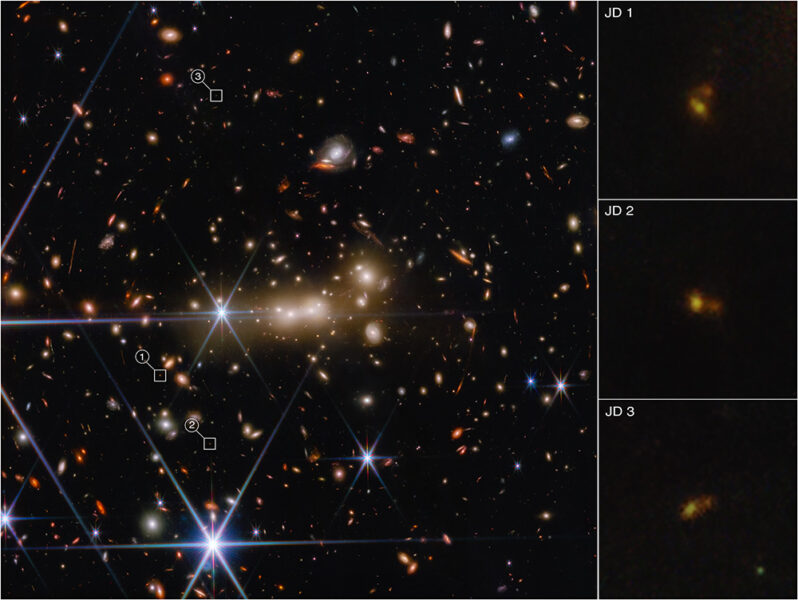New JWST images reveal that one of the most distant objects ever observed is actually two baby galaxies on a possible collision course.

Science: NASA / ESA / CSA / Dan Coe (STScI) / Rebecca Larson (UT) / Yu-Yang Hsiao (JHU); Image processing: Alyssa Pagan (STScI)
Big galaxies like the Milky Way — a spiral disk 100,000 light years across containing some 200 billion stars — are thought to come from the celestial meet-and-greets of the first galaxies, which were originally little more than tiny clumps of stars. Now, the James Webb Space Telescope (JWST) has imaged two baby galaxies that existed just 430 million years after the Big Bang, each only hundreds of light-years across. Astronomers think they might be merging, shedding light on galaxy growth in the early universe.
“Most galaxies today will have been through several merger events,” says Tiger Yu-Yang Hsiao, (Johns Hopkins University), who led the study. “So [mergers] are key to studying the formation and evolution of galaxies today. Our target is from such an early time, right at the very beginning of this process. There is much we can learn from it.”
MACS0647–JD (MACS-JD) is an extremely distant object first observed about 10 years ago. At the time, it was considered to be the most distant galaxy ever observed, and it is still one of the earliest things we can study in detail with JWST.
Generally speaking, galaxies from the dawn of time are too faint and too far away to see. The reason we can see MACS-JD is because its light has been triply lensed, magnified and distorted by a massive galaxy cluster lying in front of it from our point of view. The cluster warps spacetime, splitting the light into three images of the same system. The images are magnified by factors of eight, five, and two, so they appear brighter than other galaxies at similar distances.
Hsiao’s JWST observations of MAC-JD verified previous conclusions about its distance, size, and physical properties — but with a surprising twist. What was once seen as a single object now appears to be two baby galaxies, labeled A and B. A is brighter and larger with very recent star formation and no dust, while B looks older and has a little bit of dust. Their differing star formation histories suggest they formed farther apart, only coming together recently.
“The researchers did a very good job approaching this problem, but there is a lot of uncertainty,” says Andrea Ferrara (Scuola Normale Superiore, Italy), who was not part of the study. He suggests that while a merger is a possibility, it’s also possible that one of the galaxies is a satellite of the other. Alternatively, the two components might be part of the same galaxy.
“We do expect that galaxies at this very high redshift are in the assembly process,” he notes, but he adds that additional data about the galaxies’ motions would help clarify their relationship.
Hsiao’s team based this study, to appear in Astrophysical Journal Letters, solely on JWST images. Upcoming spectroscopic observations, also with JWST, should tell us how A and B are moving with respect to each other. If they are both part of the same galaxy, the difference between their velocities would be relatively small; if they are actually two merging galaxies, there would be a larger discrepancy. Besides shedding light on the objects’ motions, spectra will also tell us more about the chemical properties of these tiny, highly magnified galaxies observed in the early universe.
 0
0









Comments
You must be logged in to post a comment.